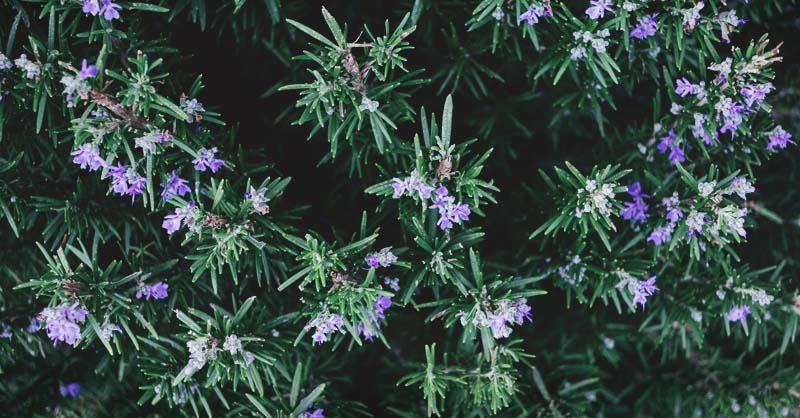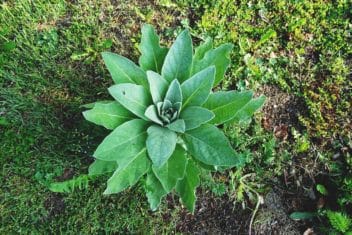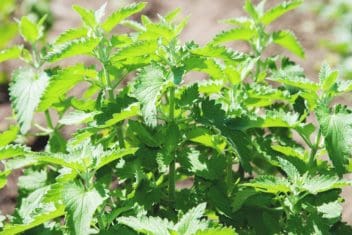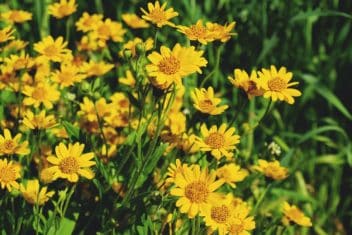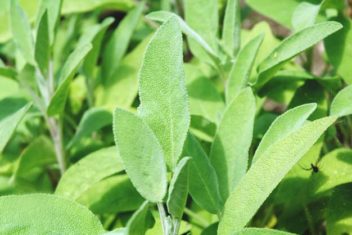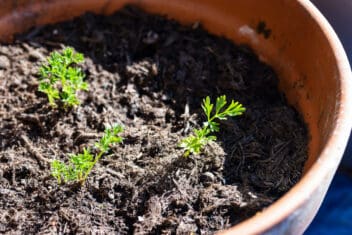Rosemary (Rosmarinus officinalis) is a beautiful evergreen that should be a staple in every herb garden. Growing rosemary is easy because it’s a low maintenance plant that’s perfectly happy in a pot on the patio or in a forgotten corner of the garden. It’s a woody perennial that adapts well to containers, making it easy to move indoors if you live in a cooler climate, so you can add the fragrant leaves to your cocktails or cooking all year long.
Speaking of cooking, rosemary adds tons of pizazz to your culinary dishes, especially Italian and French recipes. Not only that, but rosemary also smells wonderful, and the plants produce small, delicate blue, purple or white flowers which are popular with bees and other pollinators. In addition, rosemary is deer and rabbit resistant.
It’s native to the rocky, sandy soil of the Mediterranean coastal region, which means it doesn’t need a ton of water. Rosemary lives a long time, up to thirty years. It was considered a powerful herb in biblical times, and it was said that it lived thirty-three years because that was how long Christ lived. The use of rosemary dates back 5000 years, where it was recorded on the Sumerian clay tablets.
Ready to get started with this wonderfully fragrant herb?
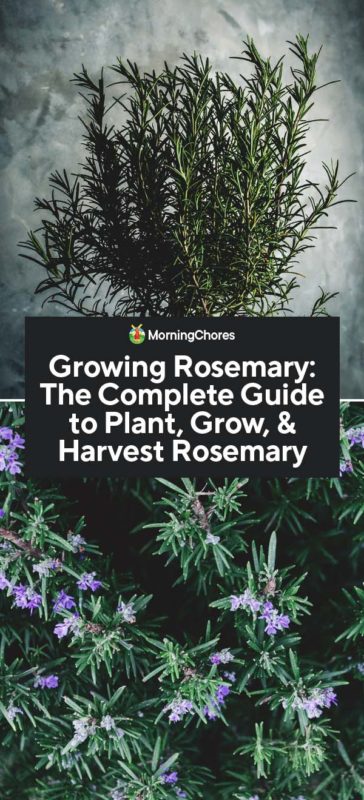
Rosemary Plant Info
- Hardiness Zones: 6 (with protection), 7, 8, 9, 10
- Soil: Loamy, sandy, PH between 6.0 and 7.0, well-drained
- Sun Exposure: Full sun, at least 6 hours of direct sunlight every day
- Planting:
- Start Indoors: Start seeds or cuttings 8 to 10 weeks before the last frost date in spring
- Hardening Off: 1 to 2 weeks before transplanting
- Transplant Outdoors: 2 weeks after the last frost date
- Spacing: 4 to 6 inches between plants and 12 to 15 inches between rows
- Depth: 1 to 2 inches
- Best Companions: Cabbage, sage, carrot, beans, broccoli
- Worst Companions: Tomato
- Watering: Water evenly allowing the soil to dry between waterings, once every 1 to 2 weeks in dry periods
- Fertilizing: Not necessary, but when growing the plant as a perennial, side dress with compost, fish emulsion, or low-nitrogen fertilizer in spring
- Common Problems: Cottony soft rot, crown gall, aerial blight, downy mildew, powdery mildew, whiteflies, aphids, spider mites, spittlebugs
- Harvest: Harvest after new growth is generated, typically 6 weeks after planting
Rosemary Varieties
There are many varieties of rosemary. Some are culinary, and some are better for landscaping.
Culinary varieties contain more essential oils which give them their pungent smell and magnificent flavoring. These varieties tend to be more upright growers, which make them easier to harvest.
Landscaping varieties have more of a horizontal growth pattern, and several varieties weep or cascade making them lovely in baskets. These varieties can be used for cooking but will not have as intense a flavor. They will, however, delight the other senses when you’re near them.
Prime Rosemary
Prime Rosemary is a culinary variety that has fast and reliable germination. The edible flowers are popular for garnishes and have a bold flavor. Try growing this rosemary if you love to cook with the fragrant herb.
Blue Boy
Blue Boy is a dwarf variety that grows six to eight inches tall, and is well suited to rock gardens and containers. The leaves are flavorful but petite. It produces tiny blue flowers which are intensely fragrant. Blue boy needs a warmer climate (zones 8-10) if it’s to be kept outside.
Arp
Arp Rosemary tolerates colder temperatures and survives outside in zones 6-10 with protection. The light green leaves have a subtle lemon scent. This variety was developed by the National Arboretum to grow three feet tall and three feet wide – so give it plenty of room.
Tuscany Blue
Tuscany Blue is a popular culinary variety with chefs. This is a tall plant and can reach four feet in height. It has deep blue flowers, loves the strong sun, and does well in containers despite its tall size. Tuscany blue grows in zones 7-10.
Miss Jessup’s Upright
Miss Jessup’s upright is another culinary favorite. It grows fairly tall at four to five feet and about two feet wide. It has slender branches with wide leaves and produces petite, pale blue flowers. Looks good in a formal or English herb garden. This cultivar received the “Award of Garden Merit” from the Royal Horticulture Society.
Pine-Scented Rosemary
Pine-scented rosemary (R. officinalis angustifolius) is the landscaping variety you often see used for topiaries. This cultivar is also used to trim into a Christmas tree shape and sold around the holidays. The leaves are more narrow and needle-like than culinary varieties. While it has a delightful piney smell, it’s not a good option for cooking.
Planting Rosemary
When it comes to sun and soil, growing rosemary is similar to growing tarragon and sage. I plant mine together in an herb area in the greenhouse.
Sun Requirements
Rosemary likes full sun, with at least 6 hours of direct sunlight every day.
Soil Requirements
In a perfect world, rosemary would have loamy, sandy soil with a pH between 6.0-7.0. The most important thing, however, is that the earth is well-draining. You can succeed at growing rosemary in poor soil, but it won’t survive in water-logged areas.
Growing Zones
Rosemary is a tender perennial and not cold hardy. It will typically overwinter in zones 7-10. With protection, people in zone 6 can usually get rosemary to come back the next spring.
Planting From Seed
Rosemary seeds can be difficult to germinate, and typically only one in four seeds will make it. If you plan to try growing rosemary by seed, sow heavily. Also, know that plants grown from seed are slower to mature.
Plant rosemary seeds indoors in a room that is 65-70°F. Sow ten weeks before the last frost in your area. Seeds take two to three weeks to germinate.
Plant seeds in a light seedling mix in three-inch peat pots. Put several seeds in each pot as germination rates are low. Gently press seeds into the soil, but not too deep because they need light to germinate. Mist seeds with water and keep them damp but not wet.
Growing Rosemary from Cuttings
Do you have a friend with a vigorous plant? Cuttings are an ideal way of growing rosemary.
Propagating with rosemary cuttings:
- Remove six inches of new growth from the plant.
- Stick the cutting vertically into a mixture of equal parts potting soil, sand, and vermiculite.
- Put four inches of the cutting into the sand mixture and leave the top two inches above.
- Place under lights or on a sunny deck.
- Keep slightly moist but not wet.
- Be patient – this process can take up to three months before plants are ready to transplant.
Transplanting
You can transplant your seedlings or purchased plants outside after the danger of frost has ended. Rosemary will grow as a perennial in southern climates and an annual in cooler climates. In Kentucky, I seem to be in between these and have had mixed results with wintering over my plants, so don’t hesitate to experiment.
My best results have come from growing rosemary in the greenhouse. In summer, I roll up the sides to give the plants plenty of air circulation. In winter they get the added protection of the plastic and protection from wind.
This worked well for three years, and I had a rosemary plant the size of a small shrub. However, last winter, during the “polar vortex,” the greenhouse temperatures dropped, and my rosemary didn’t come back.
Spacing
Leave two feet in both directions between plants. Rosemary can grow to five feet tall in warm climates.
Containers
Rosemary is ideal as a container plant, just make sure you have a pot that will give the roots plenty of room to grow. Your plant will appreciate having light sandy soil.
Rosemary makes a unique houseplant, adding a pine-looking option to the usual big-leaf houseplants you find most of the time. It will be happy out on the deck in the summer and inside by a south or west-facing window in the winter.
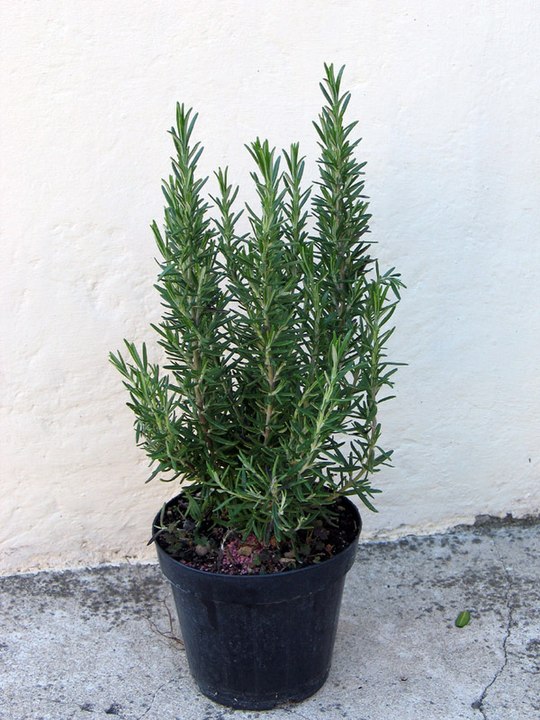
Rock Gardens
Rosemary is a favorite plant for sunny rock gardens. Landscape varieties look particularly nice in a rock garden with creeping thyme.
Caring for Rosemary
Rosemary is a pretty carefree plant.
Water
Rosemary is an extremely drought-tolerant plant, which makes it perfect for xeriscaping and those who live in the southwest.
Be careful not to overwater by allowing the top few inches of soil to dry out before you water.
Fertilizing
Rosemary doesn’t need a lot of fertilizer. I top dress with compost every spring, and that’s it.
Pruning
Cut back your plant in late fall or early spring to rejuvenate the plant. Trim lanky branches any time to encourage bushier growth.
Problems and Solutions to Growing Rosemary
Rosemary does more to prevent pests and diseases in other plants than it’s bothered by them. The best thing you can do to keep your plant healthy is to have it planted in a well-draining medium and provide lots of sun and air circulation.
Crown Gall
Crown gall is a bacteria that causes overgrowth at the soil line or on the branches of rosemary. The bacteria can live in the soil for years, and gets into plants through wounds. If your plant is infected, keep it well fertilized and watered, and it should be fine – if a little stunted. A bad infestation means you’ll have to toss your plant, though.
Avoid crown gall by planting or taking cuttings from gall-free plants. Don’t plant in soil that has had crown gall recently.
Downy Mildew
This disease is caused by an organism that creates a fuzzy white, purple, grey, or brown growth on plants. You also might see yellow mottling on leaves. It usually pops up in the spring.
Downy mildew thrives in moist conditions, so water plants in the morning so they can dry out, water at the base of plants, and keep plants pruned and separated to improve air circulation.
Powdery Mildew
This disease is often confused with downy mildew, but they’re two different things. Powdery mildew is caused by a fungus and causes curling and blisters on leaves. Eventually, the plant will be covered in a white or gray powder-like growth.
In addition to following the same moisture-control practices that you use with downy mildew, you can spray plants with neem oil or use a copper fungicide to control it.
Aphids
Aphids attack just about every plant out there, and rosemary is no exception. The small insects literally suck the life out of your plants, and they can be particularly damaging to rosemary that is grown indoors or in greenhouses.
Dislodge the little pests by spraying them off plants with a blast of water and then use neem oil to keep them from coming back.
Whiteflies
Whiteflies are related to aphids (not flies) and they damage rosemary plants in the same way: by sucking the juices out. You can spray them off plants with a blast of water and then use neem oil, as you can with aphids. Try sticky traps and attract beneficial insects to your garden to prevent future infestations.
Companion Plants for Rosemary
Rosemary makes a great companion plant and deters many pests. Plant Rosemary near:
- Carrots
- Beans
- Cabbage
- Sage
- Broccoli
Don’t grow rosemary with tomatoes.
Harvesting and Storing
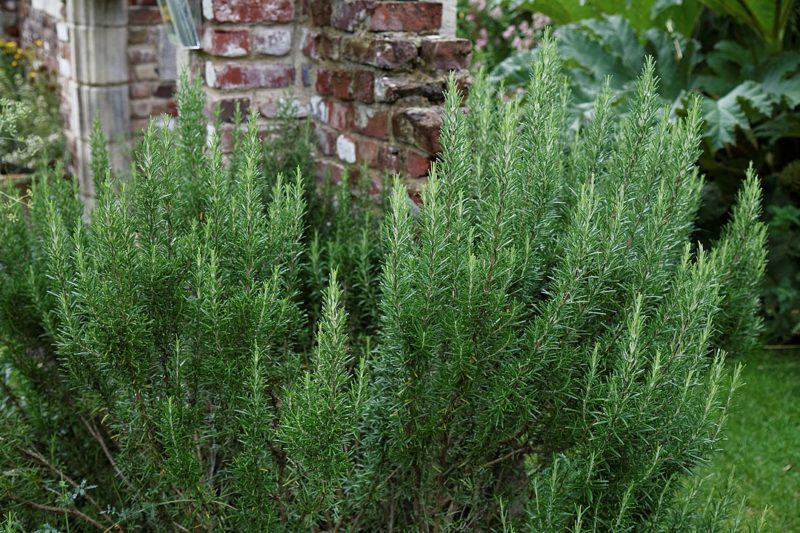
Harvest rosemary by clipping off a sprig or stem. You can harvest whenever you need but never take more than one-third of the plant.
I typically just harvest a small sprig at a time for cooking. In late summer I will cut the plant back and dry the rosemary for winter use.
Drying
There are several ways you can dry rosemary:
- Hanging – Cut sprigs at least six inches long. Tie them together at one end with either a rubber band or some ribbon. Hang them indoors or out where there is good air ventilation. You can place the bundle in a paper lunch sack with holes in it to keep off bugs and dust. Allow the springs to dry about two weeks until the leaves become brittle and fall off the stem.
- Dehydrator – If you have a dehydrator, spread sprigs evenly over the tray, so they are not touching. Set for 100°F. Depending on your humidity, it will take between one and four hours for it to dry. Check every thirty minutes, so it does not become too dry.
Store you dried rosemary in a container with a tight-fitting lid. Keep in a cool dark place. Keeps for six months.
Cooking With Rosemary
Rosemary is ideal in a variety of recipes such as soups, stews, roasted veggies or meats, and is particularly wonderful when you mix it with butter or cheese as a spread.
Have you ever put rosemary on your pizza? Do it. Cook up broccoli rabe, potato, and rosemary pizza, and it may become your new thing. If you prefer something more traditional, try grilled rosemary lamb chops. I like to use a rosemary sprig as a skewer for tomatoes on the grill.
Using Rosemary
Rosemary has numerous medicinal properties. It’s considered a tonic, stimulant, and astringent. Traditionally it has been used to soothe joint and muscle pain, improve circulation, and boost the immune system.
It’s also popular as an additive to hair and skin products and considered an effective treatment for dandruff. You can make your own hair rinse using a few sprigs of rosemary.
I like to combine rosemary, lemon peels, and lavender together in a sachet. It smells wonderful and repels insects.
As a final word on this marvelous plant, I’ll leave you with a quote from Shakespeare’s Hamlet where Ophelia is mourning Hamlets death:
There’s rosemary, that’s for remembrance;
Pray you, love, remember;
And there is pansies, that’s for thoughts.

